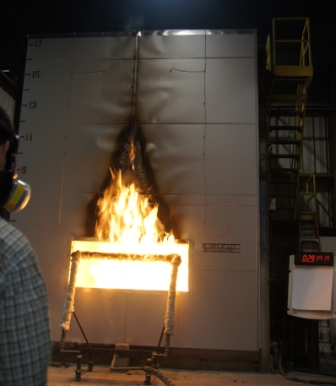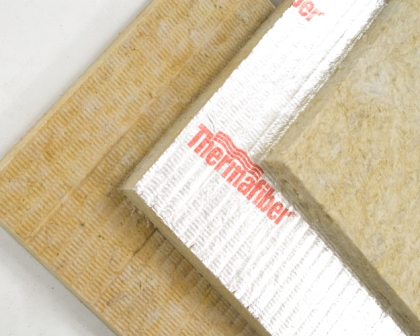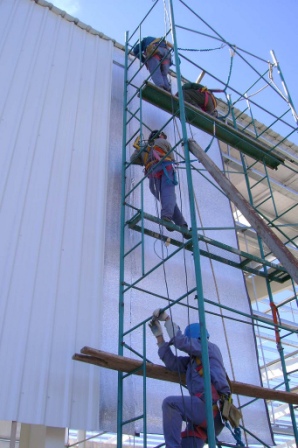Fireproofing a metal building is vital to maintaining its structural integrity
Metal is a strong, fire-retardant, noncombustible material with a very high melting point. These attributes are a real advantage for a metal building’s fire-safety rating and more importantly for its occupants’ protection. With metal buildings it is possible to achieve up to a four-hour rating on walls with cold-formed steel, giving it a great advantage over other building types. But even with its many advantages, high temperatures can still damage metal- especially when it’s unprotected.
 |
Furthermore, Austin Hess, director of business development at Thermafiber Inc., Wabash, Ind. says one concern about metal buildings is a result of one of their greatest advantages. They have large wall expanses and long-span, open areas. “They are not typically compartmentalized like other types of commercial buildings,” he says. Without discrete fire zones caused by partitioned areas, smoke and gases can travel faster throughout building areas, spreading in all direction to form a deepening layer. Smoke, rather than fire, is often the real threat. These factors reinforce the need for fireproofing of metal structures to preserve them and protect them from failure. Unprotected metal loses 50 percent of its load-carrying capacity as temperatures approach 1,100 F.
Fireproofing products aim to prevent this by helping metal buildings obtain their hourly fireresistance endurance ratings by withstanding fire impingement at a certain intensity for a specific amount of time. “Required fire ratings are determined by various factors,” says Michael C. Kerner, FAST, CSI, CDT, code development manager, ClarkDietrich Building Systems, West Chester, Ohio. “Among them are the occupancy and use of the building, the type of construction, how close the building is to other structures and how close to the property line is the structure. Additionally, areas within the same structure can have different fire ratings. For example, a furnace/boiler room may have a twohour rating, while another area may have a onehour rating.” Here are some cost-efficient ways fireproofing helps attain fire ratings, and protects buildings and their inhabitants.
In the paint
Intumescent paints are the newest form of fireproofing paint. They chemically react and expand to many times their original volume and thickness when exposed to heat. At 300 F, less than a hundred degrees higher than boiling water, their heat-sensitive ingredients react and froth up into a foam containing millions of tiny hollow cells. This provides an insulating coating or “char” that protects metal, reduces the heating rate and prolongs load-bearing capacity.
 |
Soft char intumescent paints produce a light char, which is a poor conductor of heat, thus retarding heat transfer. Typically, these materials contain a significant amount of hydrates. As the hydrates are spent, water vapor is released, which has a cooling effect. Once the water is spent, it is only the char’s insulation characteristics that can slow down heat transfer from an assembly’s exposed side to its unexposed side.
Hard char intumescent paints are produced with sodium silicates and graphite. These products can be used for exterior steel fireproofing where it is necessary to produce a more substantial char, with a quantifiable expansion pressure. With exterior fireproofing, a hydrocarbon fire must be held off with quite potentially more kinetic energy than a house fire. Intumescents that produce hard chars are not suitable for interior spray fireproofing applications.
ClarkDietrich Building Systems’ BlazeFrame fire-stopping material is a metal frame with intumescent material applied at the factory. “This product allows for the construction of a fire-rated, sound-rated and smoke-rated partition without the necessity of additional staging for fire or sound caulking later in the project,” says Robert Warr, PE, LEED AP, director of engineering services, ClarkDietrich Building Systems. “BlazeFrame provides consistent protection at the head condition of the partition, and the need to reapply spray material is eliminated. Because BlazeFrame can be installed as part of the partition system, conflicts with mechanical interferences are also eliminated.”
Sprays
Spray-Applied Fire Resistive Material (SFRM) protection systems have decreased in usage in the past decade, but still remain one of the least expensive forms of fireproofing. Formerly called cementitious mixtures, this name change happened because they are no longer cement based. They are sometimes called fiber sprays, and now have gypsum or vermiculite-based formulations. For maximum adhesion, most advise that SFRMs be applied to unprimed/unpainted substrates. They are usually a low-density material supplied in bags, and when mixed with water are sprayed onto metal as a type of slurry. They can cover complex details and many can even be used externally.
 |
The amount and type of fireproofing paint or spray is dependent on variables like steel member size, fire severity, fire rating or duration of exposure to a given fire, budget and location of project. Masking or shielding of the application area is usually required on-site. Often, applying SFRMs requires specialist contractors using specialist equipment. Northbrook, Ill.-based Underwriter’s Laboratory (UL) has a qualified SFRM contractor program intended for contractors that install spray-applied fire-resistive materials. SFRM contractors must select and install SFRMs carefully and effectively to establish a protective system for a structure to comply with architectural, code and customer requirements.
UL’s qualified SFRM contractor program includes two critical elements required of all participating contractor firms:
• Employs at least one designated responsible individual with knowledge focused on selection and installation of SFRMs as demonstrated by successfully completing UL’s exam and meeting additional program requirements.
• Establishes and effectively implements and maintains a management system focused on selection and installation of UL Classified SFRMs as demonstrated by UL audit at contractor’s facility and job site.
Boards and wool
Manufactured board materials are cut to size and fixed around steel sections, in essence “boxing” them in to provide the necessary fireproofing. They are used both where the protection system is in full view and where it is hidden. The application is dry and can take place on unpainted steelwork. The boards are factory manufactured, guaranteeing thicknesses. They are most often comprised of a proprietary board material like calcium silicate, vermiculite, perlite or gypsum (plasterboard). Since gypsum is a naturally fire-resistant mineral, it has become a leading construction material and component of fire-resistant rated wall assemblies. To ensure that these gypsum board wall assemblies are appropriate to specify in fire-rated building designs, the complete wall assembly undergoes fire tests. Fire-resistance classifications are established accordingly. There are several types of fire-resistant wall assemblies to suit a variety of applications and projects. Noncombustible, and combustible/loadbearing and non-loadbearing are examples of fire-resistant wall assemblies.
Various factors influence a board’s fire resistance. The type of gypsum board is critical. Board with glass fibers in the core provides better fire resistance than gypsum board without glass fibers. The fire resistance of wall assemblies with regular
(standard) gypsum board increases as the density of the gypsum board increases. Layering the number of gypsum board on each side of the assembly from one to two improves the fire resistance rating. Well-constructed and tested gypsum board wall assemblies offer a first line of defense against the spread of fire and lead to a more sustainable building.
 |
Hatfield, Pa.-based Laminators Inc. manufactures a complete line of aluminum composite panels for exterior cladding. “The item that is most unique to metal buildings and specifically our aluminum composite panels is that the aluminum faces on our panels do not burn when installed in an appropriate cladding system,” says Jessica A. Olff, marketing communications manager at Laminators. “All of the fire ratings and tests performed on our metal composite metal panels are predetermined by Chapter 14, Section 1407 (Metal Composite Materials) in the International Building Code.”
Mineral wool can provide fire-resistant thermal insulation in exterior and interior walls. “Mineral wool is non-combustible and provides lifesaving fire protection,” says Hess. “Mineral wool is listed in multiple fire-rated metal building wall assemblies.”
Test procedures
Developed in 1918, ASTM E119 is a standard test procedure for the fire test of building construction and materials to determine hourly ratings for an assembly. The test exposes a test specimen to a standard fire controlled to achieve specific temperatures throughout a specified time period. “It is a laboratory test utilizing a furnace to test the effects of heat on assemblies of construction materials under prescribed conditions,” says Tom Frost, senior vice president of technical services, International Code Council, Washington, D.C.
E119 hasn’t changed much in almost 100 years, and since it’s a standardized test method, it allows one material to be compared to another, under very defined conditions. But the exposure is not representative of all fire conditions because conditions vary with changes in the amount, nature and distribution of fire loading, ventilation, compartment size and configuration, and heat sink characteristics of the compartment. Variation from the test conditions or test specimen construction, such as size, materials, method of assembly, also affects the fire-test response.
“NFPA 101, the Life Safety Code references ASTM E 119 for testing fire resistance of structural elements and building assemblies,” says Tracy Vecchiarelli, associate fire protection engineer, National Fire Protection Association, Quincy, Mass. “It also references ANSI/UL 263 as another test option. Organizations like UL and ASTM have more information on testing requirements and a simple online search could help you find many manufacturers of specific products.”
[sidebar]
Curtainwalls and fire safety
Curtainwalls can be protected from heat transfer at the floor/curtainwall intersection (perimeter joint) by using materials that insulate the mullions and panels. The variety of curtainwall materials makes it impractical to specifically address them all in terms of fire protection. The critical issue is the performance of the wall in its assembled form when tested for flash-over and flame penetration at perimeter joints. It is up to the designer to understand the critical performance of the materials and the standards that define appropriate degrees of fire resistance. Design adaptability is one of the greatest advantages of the curtainwall system. With this, however, the architect/engineer must be willing to take an equally adaptive approach to making the curtainwall an effective fire barrier. Properly designed, dynamic fireresistive assemblies utilizing materials, such as mineral wool, ceramic wool, intumescent, endothermic matting, etc., are critical to the fire-resistive performance of the curtainwall system as part of a compartment. Additionally, the appropriate attachment and reinforcement of fire safety materials at vulnerable points, such as fenestration openings, must be considered an integral part of the initial design process rather than as an afterthought.–Dean Lewis, educational and technical information manager, American Architectural Manufacturers Association (AAMA), Schaumburg, Ill.





